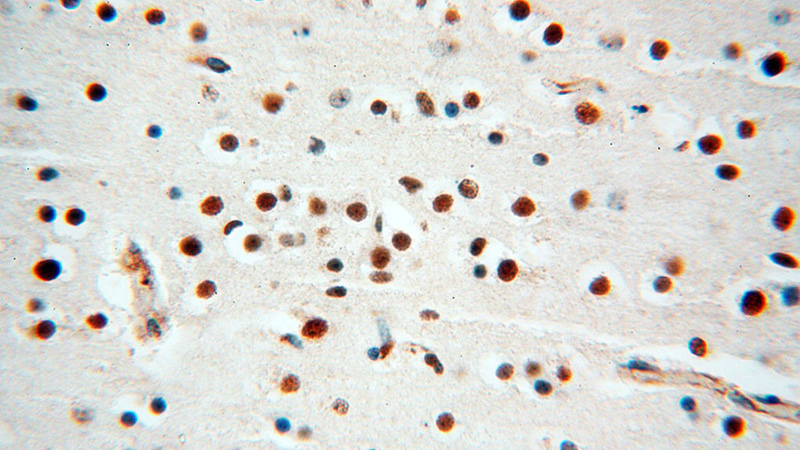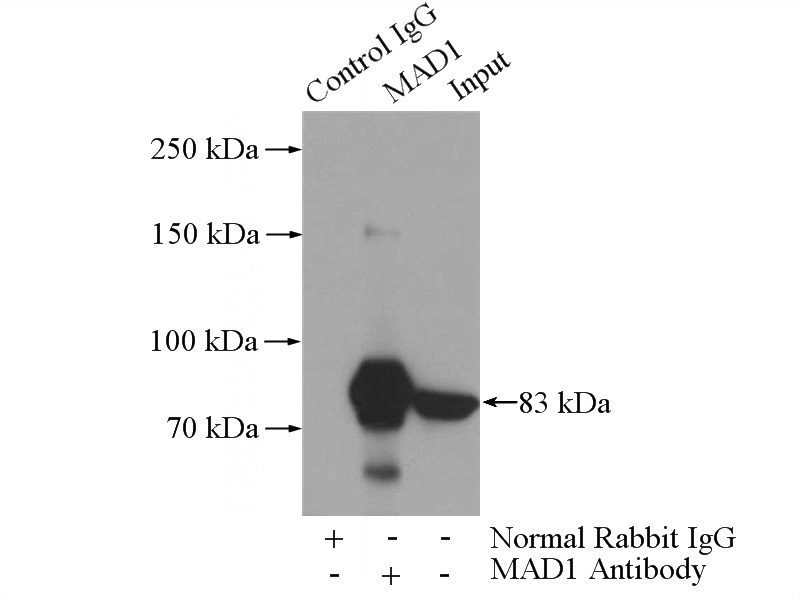-
Product Name
MAD1 antibody
- Documents
-
Description
MAD1 Rabbit Polyclonal antibody. Positive IF detected in SH-SY5Y cells, A431 cells. Positive IHC detected in human brain tissue, human kidney tissue, human ovary tissue, human placenta tissue, human skin tissue, human spleen tissue, human testis tissue. Positive WB detected in A431 cells, HeLa cells, HepG2 cells, human brain tissue, Raji cells. Positive IP detected in HeLa cells. Observed molecular weight by Western-blot: 83 kDa
-
Tested applications
ELISA, WB, IHC, IP, IF
-
Species reactivity
Human,Mouse,Rat; other species not tested.
-
Alternative names
hMAD1 antibody; HsMAD1 antibody; MAD1 antibody; MAD1 like protein 1 antibody; MAD1L1 antibody; PIG9 antibody; Tax binding protein 181 antibody; TP53I9 antibody; TXBP181 antibody
-
Isotype
Rabbit IgG
-
Preparation
This antibody was obtained by immunization of MAD1 recombinant protein (Accession Number: NM_001304523). Purification method: Antigen affinity purified.
-
Clonality
Polyclonal
-
Formulation
PBS with 0.02% sodium azide and 50% glycerol pH 7.3.
-
Storage instructions
Store at -20℃. DO NOT ALIQUOT
-
Applications
Recommended Dilution:
WB: 1:500-1:5000
IP: 1:500-1:5000
IHC: 1:20-1:200
IF: 1:20-1:200
-
Validations

A431 cells were subjected to SDS PAGE followed by western blot with Catalog No:112366(MAD1L1 antibody) at dilution of 1:500

Immunohistochemical of paraffin-embedded human brain using Catalog No:112366(MAD1L1 antibody) at dilution of 1:100 (under 40x lens)

IP Result of anti-MAD1L1 (IP:Catalog No:112366, 5ug; Detection:Catalog No:112366 1:1000) with HeLa cells lysate 880ug.

Immunofluorescent analysis of SH-SY5Y cells using Catalog No:112366(MAD1L1 Antibody) at dilution of 1:50 and Alexa Fluor 488-congugated AffiniPure Goat Anti-Rabbit IgG(H+L)
-
Background
MAD1L1 is a component of the spindle-assembly checkpoint that prevents the onset of anaphase until all chromosomes are properly aligned at the metaphase plate. It recruits MAD2L1 to unattached kinetochores. Also it is required for anchoring MAD2L1 to the nuclear periphery. In addition, it binds to the TERT promoter and represses telomerase expression, possibly by interfering with MYC binding [PMID:10049595, 12837246].
Related Products / Services
Please note: All products are "FOR RESEARCH USE ONLY AND ARE NOT INTENDED FOR DIAGNOSTIC OR THERAPEUTIC USE"
